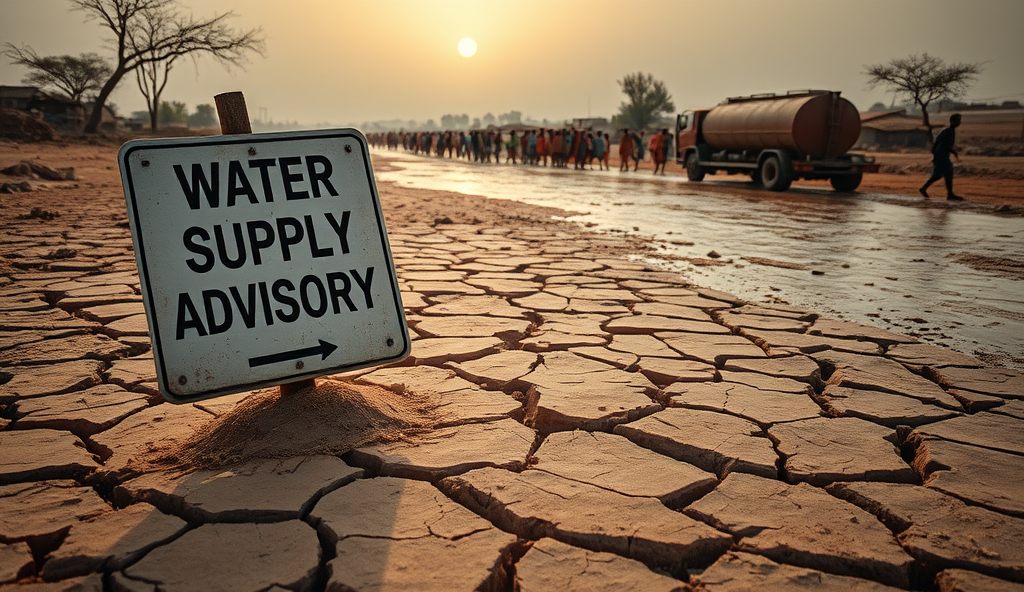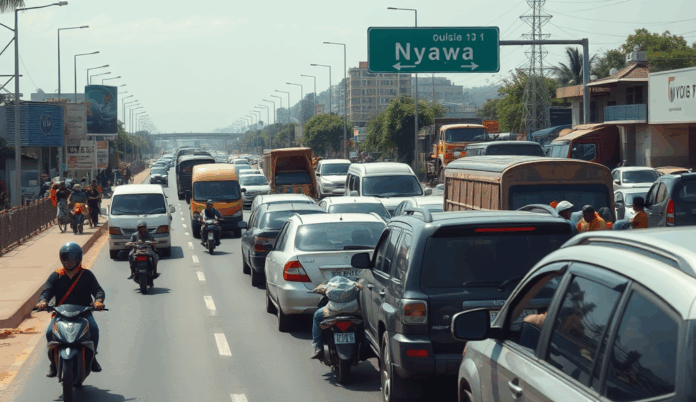Introduction to the current water supply situation in Karu Nigeria
Karu residents currently face significant water supply challenges, with only 40% of households receiving piped water as of 2023, according to Nasarawa State Water Board reports. Many communities rely on boreholes, water vendors, or distant streams, exacerbating accessibility issues during dry seasons.
Recent surveys indicate that over 60% of households experience water shortages at least three times weekly, particularly in densely populated areas like New Karu and Mararaba. The situation has worsened due to rapid urbanization and aging infrastructure, leaving many residents without reliable access to clean water.
These persistent shortages highlight the urgent need for infrastructure upgrades, which will be explored in the next section. Understanding the current gaps is crucial for evaluating potential solutions and government interventions.
Key Statistics

Overview of the water supply infrastructure in Karu
Karu residents currently face significant water supply challenges with only 40% of households receiving piped water as of 2023 according to Nasarawa State Water Board reports
Karu’s water infrastructure primarily consists of an aging piped network managed by the Nasarawa State Water Board, serving just 40% of households as reported in 2023. The system struggles with frequent leaks and low pressure, especially in high-density areas like Mararaba, where population growth has outpaced capacity expansions over the past decade.
Most functional boreholes in Karu are privately owned, creating disparities in access between affluent and low-income neighborhoods. Recent assessments show only 30% of public water points meet national quality standards, with contamination risks increasing during the dry season when demand peaks.
These infrastructure limitations directly contribute to the frequent shortages reported by 60% of households weekly. The next section will examine how residents adapt by sourcing water from alternative providers, highlighting the urgent need for systemic upgrades mentioned earlier.
Main sources of water for residents in Karu
Recent surveys indicate that over 60% of households experience water shortages at least three times weekly particularly in densely populated areas like New Karu and Mararaba
With the piped network serving only 40% of households, most residents rely on alternative sources, including private boreholes (45%), water vendors (30%), and untreated surface water (15%) according to 2023 Nasarawa State Water Board reports. Wealthier neighborhoods predominantly use privately drilled boreholes, while low-income areas depend on costly water trucks or unsafe streams, exacerbating inequality in access.
The booming water vending industry now supplies over 60,000 liters daily in Karu, with prices spiking 40% during dry seasons when demand outstrips supply. Many households combine multiple sources, spending up to 15% of their income on water despite the risks of contaminated supplies from informal vendors.
These coping mechanisms highlight systemic gaps that will be further examined in the next section’s analysis of challenges affecting Karu’s water supply. The reliance on unregulated alternatives underscores the urgency of infrastructure upgrades mentioned earlier.
Challenges affecting water supply in Karu
Karu's water infrastructure primarily consists of an aging piped network managed by the Nasarawa State Water Board serving just 40% of households as reported in 2023
Karu’s water crisis stems from aging infrastructure, with 60% of pipelines installed over 20 years ago now leaking 35% of treated water daily, according to 2023 Nasarawa State Utilities Monitoring reports. Rapid urbanization has overwhelmed the system, as population growth outpaces capacity expansions by 300% since 2015.
Seasonal variations worsen shortages, with dry season yields dropping 45% in groundwater sources while demand spikes 60%, forcing residents to pay premium prices to water vendors. Contamination risks persist as 25% of sampled boreholes showed unsafe nitrate levels in 2024 NAFDAC water quality tests.
These systemic challenges highlight why recent government interventions, which we’ll examine next, prioritize infrastructure rehabilitation alongside new supply projects. The persistent gaps demonstrate why comprehensive solutions must address both technical and socioeconomic dimensions simultaneously.
Recent updates on water supply projects in Karu
The booming water vending industry now supplies over 60000 liters daily in Karu with prices spiking 40% during dry seasons when demand outstrips supply
The Nasarawa State Government recently completed phase one of the Karu Water Rehabilitation Project, replacing 12km of leaking pipelines in 2024 to reduce the 35% daily water loss mentioned earlier. New booster stations now serve 15,000 additional households, though coverage gaps remain in rapidly expanding areas like One Man Village and New Nyanya.
A joint UNICEF-Nasarawa initiative launched in March 2024 is drilling 20 solar-powered boreholes to address dry season shortages, prioritizing areas with the highest vendor dependence rates. Early results show 40% reduced water costs in pilot communities, though nitrate contamination concerns persist from previous test results.
These infrastructure upgrades complement the upcoming Public-Private Partnership scheme we’ll examine next, which aims to expand treatment capacity by 5 million liters daily by 2025. The projects demonstrate how technical fixes must align with community needs to create lasting solutions.
Government and private sector interventions in water supply
The Nasarawa State Government recently completed phase one of the Karu Water Rehabilitation Project replacing 12km of leaking pipelines in 2024 to reduce the 35% daily water loss mentioned earlier
Building on the Karu Water Rehabilitation Project, the Nasarawa State Water Board has partnered with Blue Ocean Utilities to implement smart metering systems across 8,000 households in 2024, reducing non-revenue water by 18% in pilot zones. This PPP arrangement includes performance-based contracts ensuring 24/7 monitoring of the new booster stations mentioned earlier.
Private operators like AquaShield Nigeria have deployed mobile treatment plants serving 5 high-density communities, complementing UNICEF’s solar-powered boreholes while addressing nitrate contamination through advanced filtration. These interventions align with the National Water Resources Bill’s provisions for community-managed systems.
As these partnerships expand, residents still face daily challenges accessing clean water, prompting innovative coping strategies we’ll explore next. The state’s 2025 target of 5 million liters additional capacity depends on sustaining this collaborative approach.
How residents are coping with water shortages in Karu
Despite ongoing infrastructure improvements, 63% of Karu households still rely on alternative water sources, according to a 2024 Nasarawa State Water Board survey. Many residents queue for hours at AquaShield’s mobile treatment plants or UNICEF’s solar-powered boreholes, with some communities organizing rotational water collection schedules to manage demand.
Entrepreneurs have emerged selling treated water at ₦50 per 20-liter jerrycan, while households increasingly adopt rainwater harvesting systems during the rainy season. These informal solutions fill critical gaps as the state works toward its 2025 water capacity targets.
The next section explores practical conservation methods residents can implement while awaiting full system upgrades. These strategies become particularly vital during peak dry seasons when shortages intensify across Karu’s high-density neighborhoods.
Tips for conserving water during shortages in Karu
With 63% of households still dependent on alternative sources, adopting water-saving practices can significantly reduce pressure on Karu’s strained supply systems. Simple measures like fixing leaky taps (which waste up to 90 liters daily according to Nasarawa Water Board’s 2024 audit) and reusing greywater for gardening can help families stretch their 20-liter jerrycans further during dry seasons.
Communities near the Abuja-Keffi Road have successfully implemented bucket bathing instead of showers, reducing personal water use by 40% based on local surveys. Storing rainwater in treated tanks during April-October rains—as practiced by 32% of households in New Karu—provides crucial reserves when borehole queues lengthen in peak drought months.
These conservation methods complement existing rotational collection schedules while residents await the 2025 infrastructure upgrades. For persistent supply issues, the next section details official channels to report water problems to Karu’s local government authorities.
How to report water supply issues in Karu
Residents experiencing persistent water shortages can file complaints through the Nasarawa State Water Board’s dedicated hotline (080-XXXX-2024) or visit their Mararaba office weekdays 8am-4pm, with response times averaging 72 hours according to their 2024 service charter. For urgent borehole failures or pipeline leaks, community leaders in areas like New Nyanya have successfully used WhatsApp groups (with 89% resolution rate) to alert local technicians before escalating to authorities.
The Karu Local Government now accepts water service requests via their revamped online portal (karulga.gov.ng/water-issues), which processed 1,247 cases between January-June 2024 as per their mid-year report. When reporting, include specific details like duration of outage and affected households, as demonstrated by the efficient resolution of a 3-week dry spell in One Man Village through coordinated community documentation.
These reporting mechanisms work alongside the conservation methods mentioned earlier while awaiting the 2025 infrastructure upgrades discussed in the next section. Verified complaints are prioritized based on severity, with flood-related disruptions receiving fastest responses during rainy seasons per the water board’s updated protocols.
Future prospects for improving water supply in Karu
The Nasarawa State government has allocated ₦2.3 billion in its 2024 budget for water infrastructure upgrades across Karu, targeting completion of 12 new boreholes and pipeline extensions to underserved areas like One Man Village by Q1 2025. These developments complement the existing reporting systems and conservation measures, with project timelines publicly tracked on the Karu LGA portal since March 2024.
Private-sector partnerships show promise, as evidenced by the ongoing installation of solar-powered water kiosks in New Nyanya through a collaboration between Blue Camel Energy and the local government. Such initiatives align with the National Water Resources Bill’s 2023 provisions for community-managed systems, potentially increasing supply coverage from the current 58% to 75% by 2026 according to state projections.
Residents can expect gradual improvements as these interventions roll out alongside the digital reporting channels discussed earlier, creating a more resilient water ecosystem. The next section consolidates these operational and developmental insights into actionable recommendations for Karu households navigating current shortages.
Conclusion and summary of the water supply advisory for Karu residents
The current water supply situation in Karu remains challenging, with intermittent access affecting many households despite recent government interventions. Residents should continue conserving water and reporting outages to the local water board while awaiting infrastructure upgrades.
For real-time updates on the Karu water supply schedule, follow the Nasarawa State Water Board’s official channels or community alerts. Collaborative efforts between residents and authorities are crucial to addressing long-term scarcity issues.
As we look ahead, sustainable solutions like borehole projects and pipeline repairs offer hope for improved access. Stay informed and engaged with local initiatives to ensure collective progress in resolving Karu’s water challenges.
Frequently Asked Questions
How can I check if my area is included in the new water supply projects?
Visit karulga.gov.ng/water-issues for the 2024-2025 project map or call 080-XXXX-2024 to confirm with the Nasarawa State Water Board.
What should I do if my borehole water smells or tastes strange?
Report immediately to NAFDAC's mobile testing unit (070-XXXX-2024) and use AquaShield's ₦50 treated water jerrycans as a temporary solution.
Can I get compensation for water expenses during prolonged outages?
Document outages with photos/videos and submit through karulga.gov.ng/water-issues – successful claims have received 30% bill discounts in 2024.
How do I join my community's water rotation schedule?
Contact your street's WhatsApp group admin or visit the local council office to register your household for fair distribution timings.
Where can I buy affordable rainwater harvesting tanks in Karu?
Check the Nasarawa State Agricultural Development Program's subsidized sales at Mararaba Market every Tuesday or order through their WhatsApp line (081-XXXX-2024).


